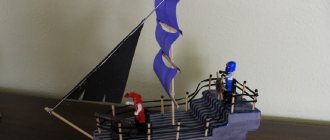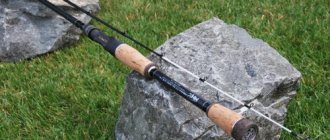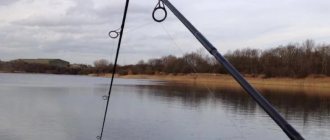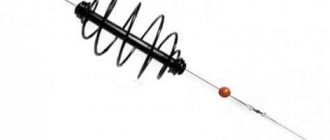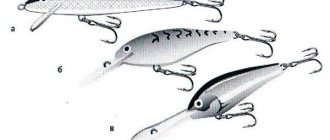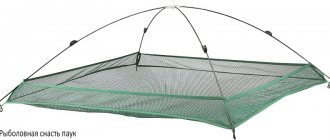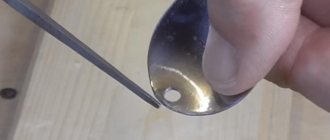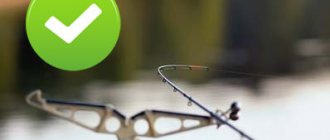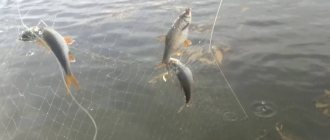Spinning rod tip repair
There are times when the tip of a spinning rod breaks, then every fisherman can fix it with his own hands.
The procedure for this is as follows:
- To replace, use the tip without fishing rings, but if these elements are still present, then you need to carefully remove the glued elements.
- It is necessary to correctly select the tip to the action, otherwise there may be an uneven degree of pressure along the rod blank.
- Visually identify which part of the broken spinning rod requires the next insertion.
- The place where the tip is fixed is cleaned. This must be done to prevent delamination of the fragile carbon.
- Pour quick-drying super glue into the carbon part, the treated fiberglass part is primed, and the parts are attached to one another.
- Go through the joint with black thread.
- A layer of fast-acting glue is applied over the wound thread to strengthen the joint.
After the glued layer has completely dried, the rod is ready for use. To match the required diameter in the carbon part, a thick section of the rod whip is worked with fine-grained sandpaper.
If the top is broken between the winding rings, approximately in the heart, the following restoration option may be required:
- Use a file to process all the ends of the broken parts. At the same time, make sure that there are no visual breaks or longitudinal damage longer than 3 mm.
- Fold the sandpaper into a tube and go over all the internal parts of the hollow halves of the rod tips.
- You will need a sewing needle of suitable length and diameter. It is needed for tight fixation in the thick part; its surface is also treated with sandpaper.
- The needle is coated with epoxy, tightly fixed in the thick part of the damaged tip, and a thin half is put on top. In this case, it is necessary to ensure that the length of the needle is at least 10 cm.
- After joining the broken elements, it is necessary to check the evenness of their installation. To do this, place the rod vertically and leave it for a day until the resin completely hardens.
- A day later, household waterproof varnish is applied to the joint, winding a strong nylon thread over it.
- After hardening, coat the repaired surface with waterproof varnish.
The result of repairing the tackle directly depends on the level of fracture, the quality of the fishing rod, and the correctly selected materials for restoration. For repairs, lightweight hollow tubes and high-quality materials are used so as not to make the rod heavier and not to change the basic characteristics of the tackle.
Action plan
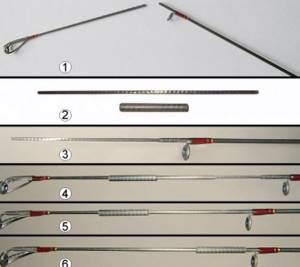
Let's consider the first method - complete replacement of the tip. The moment a fisherman realizes that this part of the fishing rod cannot be repaired, he begins to think about buying a new tip. The choice of tops is huge and you need to be able to choose them correctly.
Your action plan should be like this:
- Determine the model of your spinning rod;
- Determine the diameter of the tip;
- Go to the store and consult with a specialist;
You don't need too many actions, these three are enough. You can do it differently - in a simpler way. Take your spinning rod with you and go to the store. There they will select the right part for your model. The first method is quite simple: you take the rod, take it, they replace it for you - you pay.
The second method, that is, manual repair, is better than the first. It would seem easier to buy a new spinning rod tip than to tinker with it yourself. But that’s not the case; it’s worth buying a new part only when it’s no longer possible to fix it. In all other cases, your own hands and head will help you.
By doing repairs yourself, you will eventually develop a skill that will be useful to you later.
For example, when fishing, when you don’t always have tools with you, you can easily repair the tip of a spinning rod using scrap materials. And special craftsmen can earn money by repairing tips and not only them, but also entire rods, because they have experience in this thanks to their own labor.
In general, repair of the top consists of the following:
- Select the tip, preferably without rings, but if it turns out that it does have rings, then carefully trim the glued part and remove them.
- Proper selection of the formation is also necessary, otherwise the load on the form will be unevenly distributed.
- Visually determine which ring of the larger part of the broken spin needs to be inserted from.
- Under the place where the ring we need is attached needs to be cleaned with some kind of tool (grinder or knife). This is done so that the carbon does not delaminate.
- Take super glue (preferably one that has better contact with plastic) and pour it into the carbon part. We slightly prime the pre-prepared fiberglass part and then insert these parts into one another.
- We tightly wrap the black thread around the gluing area.
- We apply glue to the wound thread to strengthen the connection and seal it.
- Wait for the glue to dry and your top is ready.
Pass Ring
Regarding the preparation of the tip, it should be taken into account that the rings must be taken from the same spinning rod and, using the priming principle, we prime the desired part of the ring and the surface of the whip, wrap it with thread and cover it with glue on top.
The distance between the rings can be adjusted yourself, although it is advisable to proceed from the original dimensions.
You can modify the thick part of the whip with a knife until it matches the diameter in the carbon part.
The test characteristics of the spinning rod will not change much, although the rod will become a little shorter - this will not hinder you in any way when fishing.
There is also another repair method in which the length and characteristics do not change:
- First, you need to select a dense but flexible rod suitable for the role of a connector (under no circumstances use hard rods or needles, because if bitten, your tip may break again).
- The rod should fit tightly into both ends of the broken tip. After you are sure that a good connector has been selected, we proceed to preparing the epoxy resin. This resin can be purchased at any market or store. It consists of glue and hardener.
- Next, they need to be mixed in the same proportion: 1 to 1. If you have problems with the proportions, then there are probably instructions on the tubes. Apply glue to both parts of your rod, insert it into both parts of the spinning rod and connect the broken end to the main rod.
- Afterwards, wait 30-40 minutes until complete gluing. In principle, these are all the ways to repair the tip of your tackle.
Repairing a ring on a spinning rod
There are times when baits fly away due to a broken ring on the tackle. A damaged ring spoils and “shags” the fishing line, so it must be replaced if it breaks. To change the ring you will need the following parts:
- new purchased ring;
- sharp stationery knife;
- lighter;
- high-quality glue for a hot-melt gun;
- epoxy adhesive composition;
- durable synthetic thread.

Then a cut is made along the leg of the knife so as not to damage the body of the rod. Next, warm up the foot of the new element with fire from a lighter. To do this, a lighter is passed over the heated hot melt adhesive; it easily melts, forming a layer on the foot, after which the ring is fixed to the form. Next, high-quality thread wrapping is performed on the side of the installed foot. The winding ends with a secret knot. At the end of the winding, the epoxy compound is diluted, coating the ring bandage with it. After applying a layer of glue, the rod is twisted until the glue stops flowing.
Spinning knee repair
Replacing a broken knee on a fishing spinning rod is possible, but not in all real cases. The knee is damaged when the equipment is overloaded or handled carelessly. If the fishing rod breaks at a tight junction, repair is quite easy. To do this, use a point diamond tool to trim the cut, trimming the upper part of the fishing rod until the length of the future joint is equal to three diameters. This is necessary to make the connection between the broken knee and the fishing rod. Part of the broken knee is inserted into the upper half, after which fishing can continue.

If there is a break in the upper part of the fishing rod, then the situation can only be saved by applying a bandage. To separate the knee from the mandrel, it is covered with floor polish; fiberglass is suitable as a base for the bandage. The joint is treated with epoxy resin. The fiberglass cloth should be wide enough to wrap around the barrel four times. The tape is applied turn to turn, with an overlap and constant tension. To strengthen the knee, after removing the winding, the damaged area is heated from 100 to 120 C for 30 minutes.
Repairing the knee at the joint looks like this:
- The joint point is passed with fine-grained sandpaper in the inner and outer parts.
- The parts are glued together with high-quality epoxy glue, and excess adhesive is removed. A cotton swab dipped in a regular solvent can effectively remove excess adhesive.
- After the resin has completely hardened, a high-quality bandage made of dense fiberglass is installed, creating an obstacle to further destruction of the part.
This method is convenient for updating the upper and middle legs of plug-type tackle.
There are situations when the telescopic knee in the gear breaks. The best solution would be to purchase a new part and replace it. Such a part can be repaired using external and internal reinforcement. A piece of a broken telescopic fishing rod can be used as a fixation rod inside the knee. This connection is fixed with epoxy resin. From the outside, the structure is strengthened using tightly wound nylon thread and surface treatment with epoxy or varnish.
The deformation at the site of the knee injury is eliminated by heating the flattened area with a hairdryer, and then they try to align the damaged point. Winding with nylon thread, as well as a layer of epoxy resin applied on top, will also help to strengthen the restored area. All these actions contribute to the rapid restoration of fishing gear.
Telescopic fishing rod breakdowns and repairs
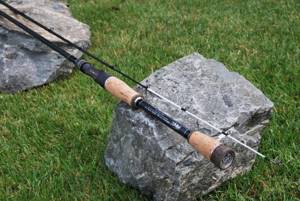
To understand how to repair telescopic fishing rods, you need to understand what breakdowns occur most often.
Most often, the knee breaks in its lower, middle or upper part.
Depending on the type of damage, a specific method of repairing the fishing rod is selected.
Very often the whip of an ordinary fly rod, which is hollow along the entire length, breaks:
- Usually the first third of the upper length of the whip is damaged. To repair it, you need to select and install a new connecting link.
- Breakage of the whip of the second knee occurs less often. Here it will help to wind the fiberglass to the desired diameter and fit it to the next cone. Of course, the fishing rod will have to be shortened a little, but this will have little effect on the quality of fishing.
- Forms with a monolithic carbon fiber insert rarely break. If used carelessly, the top of the insert may break, but it can be easily repaired with a diamond file and a new connector.
The situation is simpler with the repair of plug rods.
The whip breaks here infrequently, since the load falls on the rubber shock absorber tip. If this happens, the problem can be easily solved by selecting a new Teflon bushing.
In addition, you can straighten the broken areas and install the upper fragment in the lower part:
- The joint is treated with sandpaper inside and out.
- They are usually glued together with epoxy glue, making sure that there is no excess both inside and outside the cavity.
- A cotton swab dipped in solvent will help fight them.
- After the resin has hardened, a two-layer fiberglass bandage is installed on the outside, preventing the form from deteriorating further.
This method is suitable for repairing the upper and middle legs of plug fishing rods.
It is worth talking in more detail about how to repair the lower knees. If such a breakdown occurs, then fixing it consists solely of inserting a bushing and applying a bandage.
It is best to use a carbon fiber sleeve of similar quality to the fishing rod being repaired.
The bandage will have to be done both externally and internally. The length of the sleeve should slightly exceed 6 elbow diameters. The thin elbow should move freely in the sleeve.
The complexity of repairs sometimes forces fishermen to replace the entire docking unit.
Spinning rod handle repair
Basically, all rod handles are made from high-quality cork. Despite many obvious advantages, this material has one drawback: during prolonged use, dimples and chips form on it, leading to the destruction of this important part.
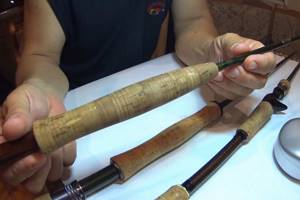
When small cracks form, repairs are carried out as follows:
- A used cork from a regular wine bottle is ground on a grater until it has the consistency of fine shavings.
- The resulting shavings are mixed with the PVA composition, and the mixture is poured into all visual defects.
- After the adhesive composition has hardened, the surface is sanded with sandpaper.
- Instead of this adhesive composition, you can use window putty that matches the tone of the wood.
In case of visually large cracks:
- Carefully cut out the damaged element, making a rectangular recess in the cork covering.
- As a basis for sealing, we take a cork without internal additional cavities, cut out the overlay to a size slightly larger than the resulting recess.
- The recess and rod insert are coated with PVA compound.
- Press the resulting insert forcefully into the damaged cavity, securing it with electrical tape.
- After 14 hours, the electrical tape is removed, and the part protruding above the recess is carefully cut off with a knife.
- The entire surface is covered with sandpaper.
All these actions must be performed when damage is detected on the handle in order to avoid complete destruction of the part.
How to repair a spinning rod with your own hands
Before you start repairing a spinning rod with your own hands, you should stock up on a set of simple tools, which includes: a hacksaw blade, a stationery knife and small-sized pliers. You should have a gas burner at hand; usually the smallest burner of a household gas stove and a lighter are used for these purposes. For the work you will need fine abrasive sandpaper, a finely cut diamond file, as well as epoxy glue and waterproof clear varnish. A solvent will serve as a degreaser for bonded surfaces. It is convenient to glue and varnish surfaces with a hard paint brush.
The list of materials that help to repair a spinning rod includes nylon thread with a diameter of 0.5 to 1.5 mm, carbon fiber that has served its age, old knees of used fishing rods (not necessarily spinning rods). Also in demand will be corks from bottles of dry or champagne wine and sets of passage rings of various diameters. It is convenient to carry out repair operations on a regular desk with a bright desk lamp. Good lighting helps to notice small cracks that, if left unnoticed, negatively affect the quality of the repair.
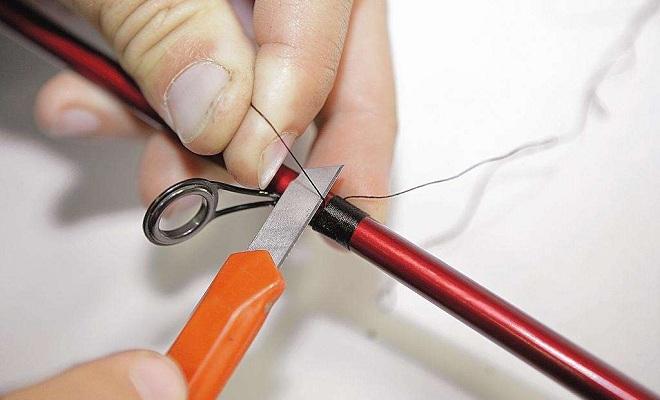
With the set of equipment and materials presented above, you can quickly and reliably make minor repairs to the tackle form. In the event of a serious breakdown, there are options for replacing the knee with a new one or transferring the gear into the hands of a master rodbuilder who specializes in restoring modern fishing equipment.
Repairing the hollow tip of a spinning rod
Tip creases are the most common defect in spinning tackle. Let's consider a special case when the tip of a spinning rod with a hollow structure breaks. The essence of the repair operation is to connect the broken part with the rest of the form. To implement the restoration of the crease, you will need to find a scupper with a suitable diameter. A spigot is a 13–15 cm long cut from an old knee . In this case, the diameter of the selected insert must fit tightly into both hollow ends of the crease. Having selected a scupper that satisfies the conditions for a high-quality connection, a preparatory operation is carried out, the essence of which is to trim the edges of the crease. In the process of trimming the edges with a hacksaw blade, they are trimmed to even planes and sanded with sandpaper.
The prepared piece of carbon fiber blank is generously smeared with glue and inserted into the broken knee, tightening the joint as tightly as possible, to the minimum size of the gap resulting from the connection. We continue repairing the spinning rod by applying waterproof varnish to the joint and winding nylon thread over this layer. The thread carefully placed at the joint remains to be soaked with the same varnish, and after waiting for the glue and coating to completely harden, which will happen no earlier than in one day, having sanded the irregularities and burrs, begin testing the gear. As a rule, this kind of work completely restores the functionality of the tackle, making its structure a little tougher.
How to fix a monolithic spinning rod tip
Some spinning rod models have a monolithic quiver tip end. Breaks in such knees are not uncommon, but repairing a broken spinning rod will not be too difficult. If the tip breaks at a distance of 5–10 cm from the tulip, use the method of connecting the joint using a tube. As in the case of restoring a hollow form, a carbon fiber insert from the old elbow will be required. Only in the version with a monolithic structure of the tip, the diameter of the selected tube should allow the workpiece cut to size to fit over the deformed parts of the elbow.
Having trimmed the ends of the crease, then, for better adhesion, the surface is sanded until it becomes visible velvety and degreased with a solvent. After the solvent has dried, glue is applied and the ends are inserted into the tube prepared in advance, pressing the ends tightly. After the glue has dried, the edges of the repair tube are cleaned with a file, covering the joint with waterproof varnish. In practice, it happens that the spinning rod breaks right at the last ring, right at the end of the tulip. This breakdown does not cause any difficulties in subsequent restoration at all.

The repair method begins with heating the broken tip on which the tulip is placed. When heated, the glue will burn out and the connecting tube of the end ring will become free. The very tip of the quivertype is cleaned with sandpaper, bringing the diameter in accordance with the diameter of the connecting tube of the tulip. The connecting elements are degreased and glued together.
Important! The tulip should fit tightly onto the tip of the quivertype.
If this condition is not met, first apply a layer of nylon thread impregnated with epoxy glue to the tip and, after the winding has dried, install the ring. The tulip placed on the glue, or rather the joint, is covered with turns of the same nylon thread and covered with a layer of moisture-resistant varnish. After such manipulation, the spinning rod remains working at the same parameters, practically without losing sensitivity and with the original factory reliability completely restored.
Handle repair
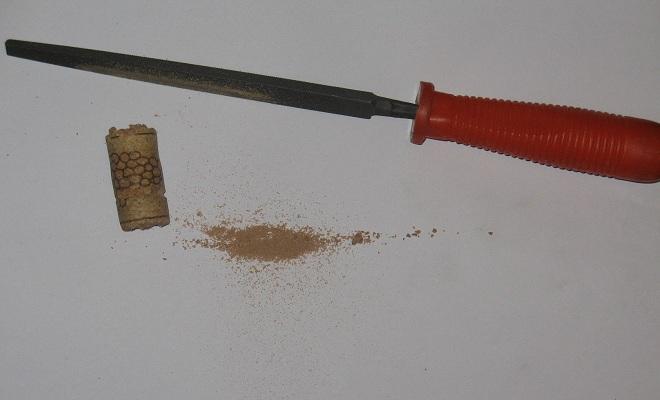
Let us please the spinning angler with the fact that restoring the handle is much easier than repairing the tip of the spinning rod. In fact, most spinning rod models are equipped with a cork handle that is comfortable in terms of tactile sensations. Cork is a rather soft and tiny material, and during the operation of the tackle, chipping, cracking and chipping occurs on the surface of the handle, which not only spoil the appearance of the tackle, but also cause inconvenience during fishing. Defects that arise can be repaired with cork crumbs, which are obtained by crushing a wine cork into fractions as small as possible.
Repair of spinning rods begins with treating chips and other defects in the handle by cleaning the surface from dirt and applying a layer of degreaser. The cork chips are poured into a small container and thoroughly mixed with waterproof glue until a thick plastic mass is obtained. The resulting composition is applied to the defective areas with a plastic spatula, firmly pressing the repair mixture into the structure of the handle. After the glue has dried, the surface is brought into perfect shape by sanding with fine-abrasive sandpaper. Corrected defects eliminated using this method will prolong the comfortable and convenient operation of the restored gear for a long time.

How to fix a spinning rod knee
Repair of the spinning rod knee is carried out in two cases: when the lower part of the plug is completely broken and when longitudinal cracks appear on the form. Fixing a broken blank is a more serious restoration operation, but the principle of execution is similar to the method of repairing the tip of a spinning rod with your own hands. To begin with, we determine the structure of the knee, which can be hollow or monolithic in design. Hollow blanks are restored by inserting an insert into the inside of the whip. The monolithic form is repaired by putting on an outer coupling made from a carbon fiber tube selected according to its diameter. Joints glued with adhesive are reinforced with reinforcement.
Important! The reinforcement is made of nylon thread with two-layer winding.
Before the first layer, the place where the inner tube is connected is coated with glue and the thread is tightly wound turn to turn to a length that overlaps the joint by at least 5 cm on each side of the defect. After drying, a second layer of thread is applied, again impregnating the reinforcing layer with an adhesive composition. With the outer coupling, these manipulations are performed at the boundaries of both joints. After drying, repair of the whip is completed by varnishing the restored surface. Cracks are eliminated by performing a reinforcement operation. A thread soaked in glue is wound onto the defective surface, extending beyond the boundaries of the crack by at least 3 cm, after the lining has completely dried, subjecting the repair area to grinding and final varnishing.
Repair of access rings
Repair of a spinning rod may be due to a defect in the guide rings. In rings, a frequent breakdown is abrasion of the surface of the liners, which disables the cord, as well as deformation of the supporting leg or all legs with complete breaking off of the ring from the blank. To replace the insert, you will need to purchase a ring that is suitable for the diameter and type of insert. Using heating with a lighter, the defective ring is carefully removed from the metal holder using the sharp tip of a knife. The clip is cleaned of the remnants of old glue, simply burning off the excess contents, and filled with fresh adhesive, after which a new liner is inserted. The remaining glue is removed, avoiding any roughness on the surface of the ring, and you continue to use the spinning rod comfortably.
By the way, exactly the same method is used to repair a tulip, with a deformed surface of the liner. A complete replacement of the ring begins with the removal of the old element of the form. To do this, open fire is used, heating and burning off the varnish and the reinforcing layer from the surface of the whip, pressing the legs of the ring to the blank. Having removed the defective ring, the surface is completely cleaned of reinforcement residues, completing the process by grinding. After degreasing, the place where the passage ring is attached is coated with epoxy glue and the ring is installed. When installing a new passage ring, it is imperative to check the alignment of the element installation with the remaining rings.
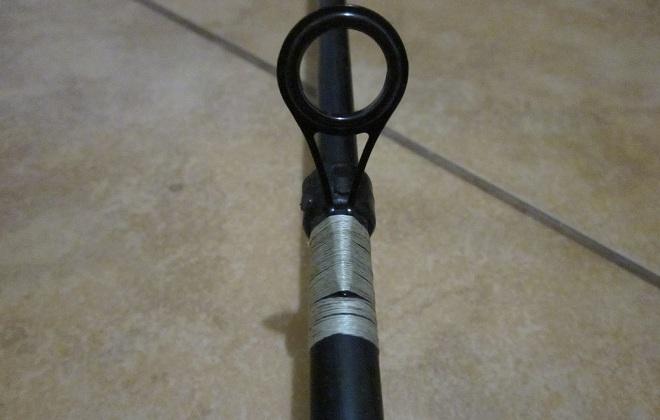
Important! The location of the rings should be on the same straight line of the form.
The ring supports are attached to the blank using nylon thread impregnated with epoxy. The legs are tightly pulled to the form with a thread, tightly applying even turns. After the glue has hardened, the fastening points are treated with fine abrasive sandpaper and covered with waterproof varnish.
Spinning blank repair
During the use of the fishing rod, the following types of breakdowns of the form may occur:
- cracks and broken butt joint of the rod whip;
- cracking or breaking of the upper knee.
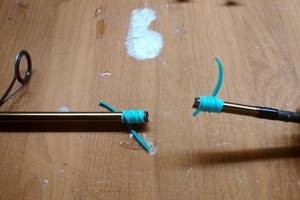
Updating the rod blank in both cases does not require any special costs. If the malfunction is detected in the upper part, close to the tulip, it is easy to correct the situation. To do this, an amateur fisherman needs to choose a suitable riding tulip. To repair this part of the rod, it is necessary to create an insert made of durable carbon fiber, suitable in size to the broken part of the blank.
The most complicated situation is when the breakage occurs in the middle of the rod. In order to restore the spinning rod, it is necessary to make an insert from carbon fiber, suitable in diameter to the broken structure, which will repeat the cone of the blank. A homemade insert is coated with adhesive and inserted inside the form. The parts of the rod are tightly fixed together, and a neat bandage is placed on top.
How to repair a broken spinning rod
Of course, sometimes rods break down in such a way that they have to be thrown away or given to professional rodbuilders who specialize in repairing and assembling a wide variety of forms.
But more often, damage to spinning rods occurs, which almost every fishing enthusiast can fix. For example:
- Fracture of the rod tip.
- Damage to pass rings and tulip.
- Fracture of the form in the middle part (of his knee).
- Damage or deterioration of the handle.
Let's take a closer look at how you can repair a spinning rod with your own hands in these cases.
Top repair
Very often you have to repair a spinning rod yourself due to a broken tip. This is a double nuisance, since the tulip is located here - the final throughput ring, which takes on the main loads.
The tips, depending on the material and design of the rod, can be hollow or solid. The method of its repair depends on this.
In order to repair a spinning rod with your own hands, you must first prepare the tools and materials:
- sharp painting knife;
- gas-burner;
- lighter;
- pliers;
- small file;
- sandpaper size 1000;
- cloth for metal;
- pieces of carbon fiber rods of various lengths and diameters for repairing a spinning rod knee that is damaged or broken;
- adhesives – waterproof PVA, epoxy, “Super glue” gel, for fixing bandages, guide rings, and repairing handles;
- waterproof clear varnish;
- nylon thread for fastening the installed access rings to the form, masking the place where the spinning rod broke;
- set of pass rings;
- corks from wine or champagne bottles.
Having prepared everything you need, you can repair both the failed last pass ring and the broken form near the butt.
Form repair
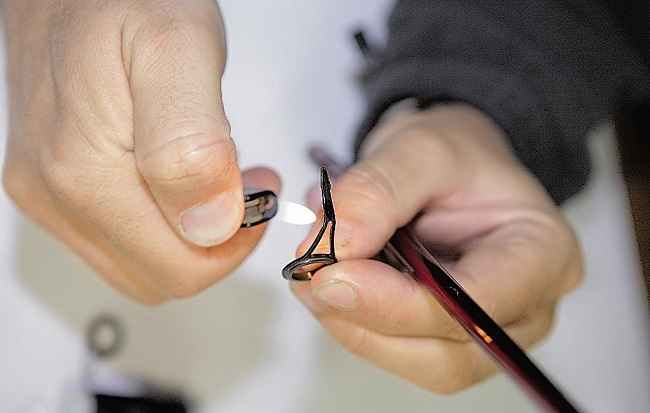
In modern two-piece plug spinning rods made of high-modulus graphite, the following types of breakdowns occur:
- cracks or breaks of the first (butt) leg of the spinning rod;
- cracking or breaking of the upper leg.
Repairing the form in both cases does not require significant expenses. It consists of the following steps:
- We inspect the rod at the point of breakage for longitudinal cracks. If they exist, the knee cannot be repaired - under load, the crack will inevitably increase in length and lead to complete failure of the entire knee.
- If no cracks are found, use a metal blade to trim the edges of the damaged knee.
- From old, but not split graphite knees from another broken fishing rod, we select and cut out a piece 10-15 cm long that fits tightly inside the parts of the broken knee - a scupper.
- If necessary, grind the piece a little with sandpaper and a fine file.
- We insert the scupper into one of the parts of the repaired knee, so that it fits tightly inside it by 7-8 cm. We generously lubricate the edge of the knee and the scupper inserted into it with epoxy glue. When repairing the butt knee, the scupper can be passed inside it by removing the plug located at the end of the handle after the spinning reel seat.
- We insert the second end of the spigot inside the other part of the broken knee so that the gap between the two joined parts of the broken knee is minimal.
- Cover the joint with epoxy glue.
- We wind a thin nylon thread over the connection, trying to match its color to the tone of the form coating.
- We cover the nylon thread bandage with waterproof varnish.
- If one of the rings of the spinning rod is very close to the place of breakage, then to strengthen the blank and disguise the bandage, remove it and fasten it above the junction of the broken parts of the knee with nylon thread.
- If the breakdown affected the varnish of the spinning rod rings or damaged the winding that attaches the ring to the blank, then it is easier to remove it and reinstall it.
As a result of such repairs, the rod retains its strength, flexibility, slightly changes the structure, but at the same time will allow you to avoid the purchase of an expensive exclusive knee. For the money spent, for any ordinary spinning player such repairs will cost a negligible amount
Repair of the tip of the spinning rod (whip)
Often the hollow whip of a fly rod breaks. To repair it, select the appropriate link that will serve as a ligament. The whip of the second knee breaks much less often. Here, tightly winding high-quality fiberglass to the required diameter will help put the tackle in order. It is then adjusted to the broken cone. For this purpose, the rod is shortened, which does not in any way affect the final quality of fishing.

Forms with a monolithic element made of carbon fiber are much less likely to break down. During careless use, the top at the insertion point may break; it can be easily restored using a new connector.
In plug varieties of rods, a broken whip is a rare situation. If a fracture does occur, a Teflon bushing will help correct the situation.
High-quality varnish for restoring gear
When repairing gear yourself, high-quality epoxy compounds play a special role, since they will be the connecting component between the winding and the repaired part of the rod. Therefore, the choice of resin must be approached with the utmost seriousness. The best option here would be vinyl ester resins or polyester compounds.
Vinyl ester compounds have the best performance, because... they are porous - during the curing process, gases are formed in the form of microbubbles, which reduces the strength at the moment of bending, and the elasticity index of this material is 4.5%. Vinylester can withstand greater bending before cracking when broken. The main task of the binder is to provide a rigid connection between the parts of the base.
How to protect your spinning rod from damage
Use a knotless clasp. Fishermen know many ways to tie a knot, but it is because of them that the strength of the cord is reduced by 20%. Therefore, the fastener will be an excellent alternative to a knot; it will protect the cord from chafing and help distribute the load correctly.
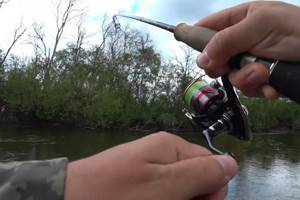
Make sure that the cord does not get tangled in the upper ring of the rod. In the absence of control, the overlap is not observed, the leash is tensioned, the wobbler comes off and flies to the middle of the reservoir. To prevent this, before making a request, you must place your index finger on the cord close to the reel and press several times. If the bait moves easily, this indicates the absence of entanglement. Hide jig baits and wobblers from the rays of the open sun in the shade so that the fragile wobblers do not melt and the color of the surface of the bait does not peel off. Therefore, it is best to store gear in plastic boxes or a suitcase.
If the inertial reel of a spinning rod is broken, then fishing is doomed to failure. But don’t despair, because you can fix a minor problem right on the spot.
Attention! A true fishing master will never go fishing without the necessary additional equipment to eliminate possible malfunctions. This rule also applies to a set of gear for repairs; you need to stock up on the necessary tools to restore a broken fishing rod, which are available in any fishing store.
